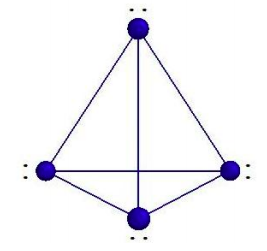6.9: P₄
- Page ID
- 149287
Td - Tetrahedral Symmetry for P4
The following Raman and IR frequencies have been observed for the tetrahedral P4 molecule. Is the assignment of tetrahedral geometry to this molecule in agreement with the spectroscopic data? Explain.
\[ \begin{pmatrix} R & R & R,IR \\ \frac{614}{ \text{cm}} & \frac{372}{ \text{cm}} & \frac{466}{ \text{cm}} \end{pmatrix} \nonumber \]

\[ \begin{matrix} ~ & \begin{array} E E & C_3 & C_2 & S_4 & \sigma \end{array} \\ C_{Td} = & \begin{pmatrix} 1 & 1 & 1 & 1 & 1 \\ 1 & 1 & 1 & -1 & -1 \\ 2 & -1 & 2 & 0 & 0 \\ 3 & 0 & -1 & 1 & -1 \\ 3 & 0 & -1 & -1 & 1 \end{pmatrix} & \begin{array} A A_1:~x^2 + y^2+z^2 \\ A_2 \\ E:~2z^2-x^2-y^2,~x^-y^2 \\ T_1:~(R_x,~R_y,~R_z) \\ T_2:~ (x,~y,~z),~(xy,~xz,~yz) \end{array} & Td = \begin{pmatrix} 1 \\ 8 \\ 3 \\ 6 \\ 6 \end{pmatrix} & \Gamma_{uma} = \begin{pmatrix} 4 \\ 1 \\ 0 \\ 0 \\ 2 \end{pmatrix} & \Gamma_{bonds} = \begin{pmatrix} 6 \\ 0 \\ 2 \\ 0 \\ 2 \end{pmatrix} \end{matrix} \nonumber \]
\[ \begin{matrix} A_1 = (C_{Td}^T)^{<1>} & A_2 = (C_{Td}^T)^{<2>} & E = (C_{Td}^T)^{<3>} & T_1 = (C_{Td}^T)^{<4>} \\ T_2 = (C_{Td}^T)^{<5>} & \Gamma_{tot} = \overrightarrow{( \Gamma_{uma} T_2)} & h = \sum Td & \Gamma_{tot}^T = \begin{pmatrix} 12 & 0 & 0 & 0 & 2 \end{pmatrix} & i = 1 .. 5 \end{matrix} \nonumber \]
\[ \begin{matrix} \Gamma_{vib} = \Gamma_{tot} - T_1 - T_2 & \text{Vib}_i = \frac{ \sum \overrightarrow{ \left[ Td (C_{Td}^T )^{<i>} \Gamma_{vib} \right]}}{h} & \text{Vib} = \begin{pmatrix} 1 \\ 0 \\ 1 \\ 0 \\ 1 \end{pmatrix} \begin{array} A A_1:~x^2 + y^2+z^2 \\ A_2 \\ E:~2z^2-x^2-y^2,~x^-y^2 \\ T_1:~(R_x,~R_y,~R_z) \\ T_2:~ (x,~y,~z),~(xy,~xz,~yz) \end{array} \\ \Gamma_{stretch} = \Gamma_{bonds} & \text{Stretch}_i = \frac{ \sum \overrightarrow{ \left[ Td (C_{Td}^T )^{<i>} \Gamma_{stretch} \right]}}{h} & \text{Stretch} = \begin{pmatrix} 1 \\ 0 \\ 1 \\ 0 \\ 1 \end{pmatrix} \begin{array} A A_1:~x^2 + y^2+z^2 \\ A_2 \\ E:~2z^2-x^2-y^2,~x^-y^2 \\ T_1:~(R_x,~R_y,~R_z) \\ T_2:~ (x,~y,~z),~(xy,~xz,~yz) \end{array} \\ \Gamma_{bend} = \Gamma_{vib} - \Gamma_{stretch} & \text{Bend}_i = \frac{ \sum \overrightarrow{ \left[ Td (C_{Td}^T )^{<i>} \Gamma_{bend} \right]}}{h} & \text{Bend} = \begin{pmatrix} 0 \\ 0 \\ 0 \\ 0 \\ 0 \end{pmatrix} \begin{array} A A_1:~x^2 + y^2+z^2 \\ A_2 \\ E:~2z^2-x^2-y^2,~x^-y^2 \\ T_1:~(R_x,~R_y,~R_z) \\ T_2:~ (x,~y,~z),~(xy,~xz,~yz) \end{array} \end{matrix} \nonumber \]
The group theoretical analysis assuming tetrahedral geometry is in excellent agreement with the spectroscopic data. Group theory predicts one IR active mode, and that it is coincident with a Raman frequency. This is observed with the T2 vibration. In addition theory predicts that there are two additional Raman active modes A1 and E.

